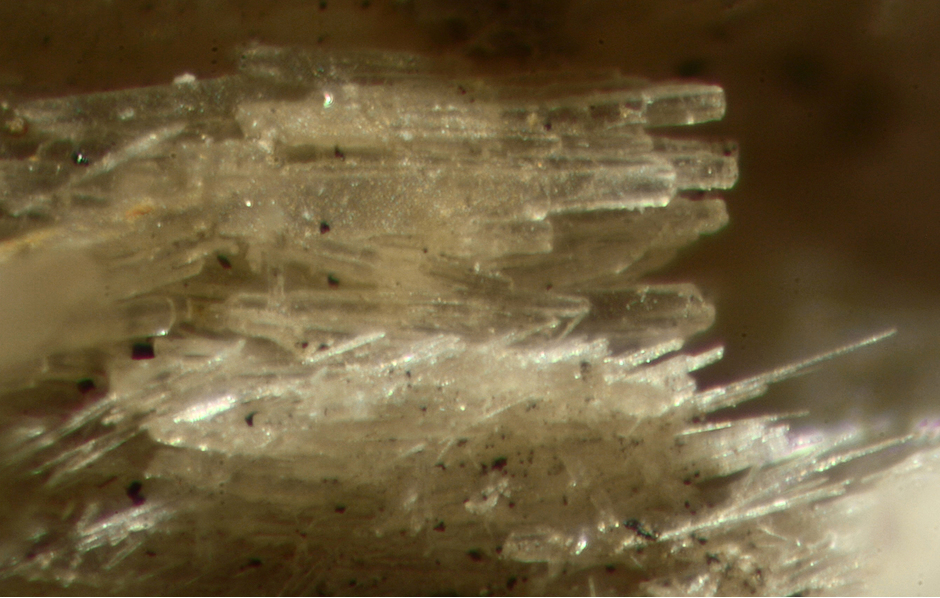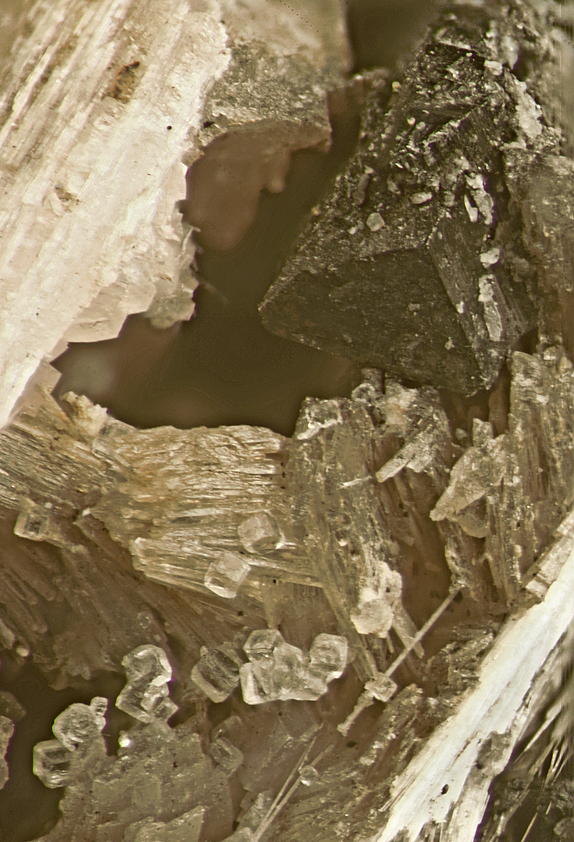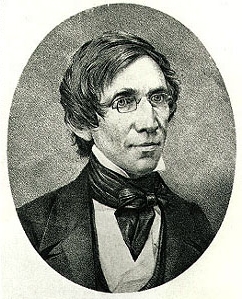Torreyite
A valid IMA mineral species - grandfathered
This page is currently not sponsored. Click here to sponsor this page.
About Torreyite
Formula:
(Mg,Mn2+)7◻2Mn2+2Zn4(SO4)2(OH)22 · 8H2O
Colour:
Rarely colourless, white, usually light brown with a red gray tint, rarely very pale blue gray; colourless in transmitted light.
Lustre:
Vitreous, Sub-Vitreous, Pearly, Dull
Hardness:
3
Specific Gravity:
2.665
Crystal System:
Monoclinic
Name:
Named in 1949 by Joan Prewitt-Hopkins in honor of John Torrey [August 15, 1796 New York, New York, USA - March 10, 1873 New York, New York, USA], American medical doctor, botanist, mineralogist and chemist; a founding member of the New York Lyceum of Natural History and its first Curator, and subsequently its President. He was a Professor of Chemistry, an author, and was appointed U.S. Assayer for the new U.S. mint in New York City in 1853. He studied the minerals of the Franklin deposits in New Jersey. Originally called "delta-mooreite", but renamed when it was discovered that the two species have a different structure.
Isostructural with:
The magnesium analogue of Lawsonbauerite.
A secondary mineral occurring in manganese-rich veinlets and fractures in the Precambrian metamorphosed Zn-Mn-Fe deposit at Sterling Hill, Ogdensburg, NJ. Torreyite does not particularly resemble mooreite with which it may be associated. Torrey crystals are very rare, but are essentially rod-like to slightly bladed rods. Torreyite may be confounded with torreyite when massive, but when in contact the torreyite is frequently a dull brown with a slightly red tint while associated mooreite in slightly lighter in color and an ashen tan color. When a cleavage may be observed, mooreite has a micaceous appearance with a pearly luster.
A secondary mineral occurring in manganese-rich veinlets and fractures in the Precambrian metamorphosed Zn-Mn-Fe deposit at Sterling Hill, Ogdensburg, NJ. Torreyite does not particularly resemble mooreite with which it may be associated. Torrey crystals are very rare, but are essentially rod-like to slightly bladed rods. Torreyite may be confounded with torreyite when massive, but when in contact the torreyite is frequently a dull brown with a slightly red tint while associated mooreite in slightly lighter in color and an ashen tan color. When a cleavage may be observed, mooreite has a micaceous appearance with a pearly luster.
Unique Identifiers
Mindat ID:
4000
Long-form identifier:
mindat:1:1:4000:2
GUID
(UUID V4):
(UUID V4):
e378c044-7524-4d95-8263-818555db1e1f
IMA Classification of Torreyite
Approved, 'Grandfathered' (first described prior to 1959)
IMA Formula:
Mg9Zn4(SO4)2(OH)22 · 8H2O
First published:
1929
Classification of Torreyite
7.DD.40
7 : SULFATES (selenates, tellurates, chromates, molybdates, wolframates)
D : Sulfates (selenates, etc.) with additional anions, with H2O
D : With only medium-sized cations; sheets of edge-sharing octahedra
7 : SULFATES (selenates, tellurates, chromates, molybdates, wolframates)
D : Sulfates (selenates, etc.) with additional anions, with H2O
D : With only medium-sized cations; sheets of edge-sharing octahedra
31.1.4.1
31 : HYDRATED SULFATES CONTAINING HYDROXYL OR HALOGEN
1 : (AB)m(XO4)pZq·xH2O, where m:p > 6:1
31 : HYDRATED SULFATES CONTAINING HYDROXYL OR HALOGEN
1 : (AB)m(XO4)pZq·xH2O, where m:p > 6:1
25.9.11
25 : Sulphates
9 : Sulphates of Mn
25 : Sulphates
9 : Sulphates of Mn
Mineral Symbols
As of 2021 there are now IMA–CNMNC approved mineral symbols (abbreviations) for each mineral species, useful for tables and diagrams.
| Symbol | Source | Reference |
|---|---|---|
| Try | IMA–CNMNC | Warr, L.N. (2021). IMA–CNMNC approved mineral symbols. Mineralogical Magazine, 85(3), 291-320. doi:10.1180/mgm.2021.43 |
Physical Properties of Torreyite
Vitreous, Sub-Vitreous, Pearly, Dull
Transparency:
Transparent, Translucent
Comment:
Frequently dull
Colour:
Rarely colourless, white, usually light brown with a red gray tint, rarely very pale blue gray; colourless in transmitted light.
Comment:
May be tan to light brown as a surface coating when slightly oxidized.
Streak:
White to colorless
Hardness:
3 on Mohs scale
Tenacity:
Brittle
Cleavage:
Distinct/Good
On {010}, good.
On {010}, good.
Fracture:
Micaceous
Comment:
Micaceous is an accurate description of the cleavage except that the folia are not broad as in a platy mica, but the cleavage follows the rod-like habit common to the mineral.
Density:
2.665 g/cm3 (Measured) 2.65 g/cm3 (Calculated)
Optical Data of Torreyite
Type:
Biaxial (-)
RI values:
nα = 1.570 nβ = 1.584 nγ = 1.585
2V:
Measured: 40° , Calculated: 28°
Birefringence:
0.015
Max Birefringence:
δ = 0.015

Image shows birefringence interference colour range (at 30µm thickness)
and does not take into account mineral colouration.
and does not take into account mineral colouration.
Surface Relief:
Moderate
Dispersion:
r > v
Pleochroism:
Non-pleochroic
Comments:
Refractive index is decidedly higher than mooreite
Chemistry of Torreyite
Mindat Formula:
(Mg,Mn2+)7◻2Mn2+2Zn4(SO4)2(OH)22 · 8H2O
Crystallography of Torreyite
Crystal System:
Monoclinic
Class (H-M):
2/m - Prismatic
Space Group:
P21/b
Setting:
P21/c
Cell Parameters:
a = 10.522 Å, b = 9.433 Å, c = 16.443 Å
β = 94.91°
β = 94.91°
Ratio:
a:b:c = 1.115 : 1 : 1.743
Unit Cell V:
1,626.04 ų (Calculated from Unit Cell)
Z:
2
Morphology:
Massive; granular to foliated.
Twinning:
Intricately polysynthetically twinned with twin plane in the zone [010] (visible under magnification).
X-Ray Powder Diffraction
Powder Diffraction Data:
| d-spacing | Intensity |
|---|---|
| 10.2 Å | (100) |
| 8.0 Å | (10) |
| 6.93 Å | (5) |
| 6.10 Å | (30) |
| 5.16 Å | (50) |
| 4.69 Å | (10) |
| 4.52 Å | (20) |
| 4.10 Å | (5) |
| 3.84 Å | (40) |
| 3.71 Å | (10) |
| 3.47 Å | (20) |
| 3.29 Å | (20) |
| 3.13 Å | (10) |
| 2.915 Å | (5) |
| 2.795 Å | (2) |
| 2.729 Å | (40) |
| 2.666 Å | (5) |
| 2.606 Å | (10) |
| 2.552 Å | (2) |
| 2.480 Å | (5) |
| 2.376 Å | (5) |
| 2.291 Å | (2) |
| 2.229 Å | (5) |
| 2.096 Å | (1) |
| 2.042 Å | (1) |
| 1.855 Å | (1) |
| 1.798 Å | (2) |
| 1.764 Å | (5) |
| 1.735 Å | (5) |
| 1.697 Å | (10) |
| 1.622 Å | (1) |
| 1.587 Å | (5) |
| 1.566 Å | (50) |
| 1.533 Å | (2) |
| 1.501 Å | (5) |
| 1.401 Å | (2) |
Comments:
ICDD 33-874; pattern superficially resembles that of mooreite, but with a slight shift to larger d spacings. There are also mismatching d values when compared to mooreite.
Geological Environment
Paragenetic Mode(s):
| Paragenetic Mode | Earliest Age (Ga) |
|---|---|
| High-𝑇 alteration and/or metamorphism | |
| 32 : Ba/Mn/Pb/Zn deposits, including metamorphic deposits |
Type Occurrence of Torreyite
Place of Conservation of Type Material:
Harvard University, Cambridge, Massachusetts, USA, 113732.
Geological Setting of Type Material:
Secondary veinlets and fractures in a Pre-cambrian metamorphosed Zn-Mn-Fe deposit.
Associated Minerals at Type Locality:
Reference:
Bauer, L.H., Berman, H. (1929) Mooreite, a new mineral and fluoborite from Sterling Hill, New Jersey. American Mineralogist, 14, 165-172.
Synonyms of Torreyite
Other Language Names for Torreyite
Common Associates
Associated Minerals Based on Photo Data:
| 17 photos of Torreyite associated with Pyrochroite | Mn(OH)2 |
| 13 photos of Torreyite associated with Mooreite | Mg9◻2Mn2Zn4(SO4)2(OH)26 · 8H2O |
| 7 photos of Torreyite associated with Fluorite | CaF2 |
| 1 photo of Torreyite associated with Rhodochrosite | MnCO3 |
| 1 photo of Torreyite associated with Sussexite | Mn2+BO2(OH) |
Related Minerals - Strunz-mindat Grouping
| 7.DD. | Asagiite | NiCu4(SO4)2(OH)6 · 6H2O |
| 7.DD.05 | Felsőbányaite | Al4(SO4)(OH)10 · 4H2O |
| 7.DD.07 | Llantenesite | Cu6Al[SeO4](OH)12Cl · 3H2O |
| 7.DD.10 | Langite | Cu4(SO4)(OH)6 · 2H2O |
| 7.DD.10 | Posnjakite | Cu4(SO4)(OH)6 · H2O |
| 7.DD.10 | Wroewolfeite | Cu4(SO4)(OH)6 · 2H2O |
| 7.DD.10 | Gobelinite | CoCu4(SO4)2(OH)6 · 6H2O |
| 7.DD.10 | Fehrite | MgCu4(SO4)2(OH)6 · 6H2O |
| 7.DD.15 | Spangolite | Cu6Al(SO4)(OH)12Cl · 3H2O |
| 7.DD.15 | Kobyashevite | Cu5(SO4)2(OH)6 · 4H2O |
| 7.DD.15 | Unnamed (Dimorph of Devilline) | CaCu4(SO4)2(OH)6 · 3H2O |
| 7.DD.20 | Ktenasite | ZnCu4(SO4)2(OH)6 · 6H2O |
| 7.DD.25 | Christelite | Cu2Zn3(SO4)2(OH)6 · 4H2O |
| 7.DD.30 | Campigliaite | Mn2+Cu4(SO4)2(OH)6 · 4H2O |
| 7.DD.30 | Devilline | CaCu4(SO4)2(OH)6 · 3H2O |
| 7.DD.30 | Orthoserpierite | Ca(Cu,Zn)4(SO4)2(OH)6 · 3H2O |
| 7.DD.30 | Serpierite | Ca(Cu,Zn)4(SO4)2(OH)6 · 3H2O |
| 7.DD.30 | Niedermayrite | CdCu4(SO4)2(OH)6 · 4H2O |
| 7.DD.30 | Edwardsite | Cu3Cd2(SO4)2(OH)6 · 4H2O |
| 7.DD.35 | Carrboydite | (Ni1-xAlx)(SO4)x/2(OH)2 · nH2O |
| 7.DD.35 | Glaucocerinite | (Zn1-xAlx)(OH)2(SO4)x/2 · nH2O |
| 7.DD.35 | Honessite | (Ni1-xFe3+x)(OH)2[SO4]x/2 · nH2O |
| 7.DD.35 | Hydrohonessite | (Ni1-xFe3+x)(OH)2(SO4)x/2 · nH2O |
| 7.DD.35 | Motukoreaite | Mg6Al3(OH)18[Na(H2O)6][SO4]2 · 6H2O |
| 7.DD.35 | Mountkeithite | [(Mg1-xFe3+x)(OH)2][SO4]x/2 · nH2O |
| 7.DD.35 | Shigaite | Mn6Al3(OH)18[Na(H2O)6](SO4)2 · 6H2O |
| 7.DD.35 | Wermlandite | Mg7Al2(OH)18[Ca(H2O)6][SO4]2 · 6H2O |
| 7.DD.35 | Woodwardite | Cu1-xAlx(OH)2(SO4)x/2 · nH2O |
| 7.DD.35 | Zincaluminite | Zn6Al6(SO4)2(OH)16 · 5H2O |
| 7.DD.35 | Hydrowoodwardite | (Cu1-xAlx)(OH)2[SO4]x/2 · nH2O |
| 7.DD.35 | Zincowoodwardite | Zn1-xAlx(OH)2[SO4]x/2 · nH2O |
| 7.DD.35 | Natroglaucocerinite | Zn6Al3(OH)18[Na(H2O)6](SO4)2 · 6H2O |
| 7.DD.35 | Nikischerite | Fe2+6Al3(OH)18[Na(H2O)6](SO4)2 · 6H2O |
| 7.DD.40 | Isselite | Cu6(SO4)(OH)10 · 5H2O |
| 7.DD.40 | Lawsonbauerite | (Mn2+,Mg)9Zn4(SO4)2(OH)22 · 8H2O |
| 7.DD.45 | Mooreite | Mg9◻2Mn2Zn4(SO4)2(OH)26 · 8H2O |
| 7.DD.45 | Hodgesmithite | (Cu,Zn)6Zn(SO4)2(OH)10 · 3H2O |
| 7.DD.47 | Lahnsteinite | Zn4(SO4)(OH)6 · 3H2O |
| 7.DD.50 | Namuwite | Zn4(SO4)(OH)6 · 4H2O |
| 7.DD.50 | Minohlite | (Cu,Zn)7(SO4)2(OH)10 · 8H2O |
| 7.DD.52 | Lauraniite | Cu6Cd2(SO4)2(OH)12 · 5H2O |
| 7.DD.55 | Bechererite | Zn7Cu(OH)13[(SiO(OH)3(SO4)] |
| 7.DD.60 | Ramsbeckite | (Cu,Zn)15(SO4)4(OH)22 · 6H2O |
| 7.DD.65 | Vonbezingite | Ca6Cu3(SO4)3(OH)12 · 2H2O |
| 7.DD.70 | Redgillite | Cu6(SO4)(OH)10 · H2O |
| 7.DD.75 | Chalcoalumite | CuAl4(SO4)(OH)12 · 3H2O |
| 7.DD.75 | Nickelalumite | NiAl4(SO4)(OH)12(H2O)3 |
| 7.DD.75 | Kyrgyzstanite | ZnAl4(SO4)(OH)12 · 3H2O |
| 7.DD.80 | Guarinoite | Zn6(SO4)(OH)10 · 5H2O |
| 7.DD.80 | Schulenbergite | (Cu,Zn)7(SO4)2(OH)10 · 3H2O |
| 7.DD.80 | Thérèsemagnanite | NaCo4(SO4)(OH)6Cl · 6H2O |
| 7.DD.80 | UM1992-30-SO:CCuHZn | (Zn,Cu)7(SO4,CO3)2(OH)10 · 3H2O |
| 7.DD.85 | Montetrisaite | Cu6(SO4)(OH)10 · 2H2O |
Fluorescence of Torreyite
Not fluorescent in UV
Other Information
Notes:
Soluble in acids.
Health Risks:
No information on health risks for this material has been entered into the database. You should always treat mineral specimens with care.
Internet Links for Torreyite
mindat.org URL:
https://www.mindat.org/min-4000.html
Please feel free to link to this page.
Please feel free to link to this page.
Search Engines:
External Links:
Mineral Dealers:
References for Torreyite
Reference List:
Bauer, L. H., Berman, Harry (1929) Mooreite, a new mineral, and fluoborite from Sterling Hill, New Jersey. American Mineralogist, 14 (5) 165-172 (as delta-mooreite)
Prewitt-Hopkins, Joan (1949) X-ray study of holdenite, mooreite and torreyite. American Mineralogist, 34 (7-8) 589-595
Dunn, Pete J., Peacor, Donald R., Sturman, B. Darko (1979) Lawsonbauerite, a new mineral from the Sterling Hill mine, New Jersey, and new data for torreyite. American Mineralogist, 64 (9-10) 949-952
Localities for Torreyite
Locality List
 - This locality has map coordinates listed.
- This locality has map coordinates listed.
 - This locality has estimated coordinates.
ⓘ - Click for references and further information on this occurrence.
? - Indicates mineral may be doubtful at this locality.
- This locality has estimated coordinates.
ⓘ - Click for references and further information on this occurrence.
? - Indicates mineral may be doubtful at this locality.
 - Good crystals or important locality for species.
- Good crystals or important locality for species.
 - World class for species or very significant.
(TL) - Type Locality for a valid mineral species.
(FRL) - First Recorded Locality for everything else (eg varieties).
- World class for species or very significant.
(TL) - Type Locality for a valid mineral species.
(FRL) - First Recorded Locality for everything else (eg varieties).
All localities listed without proper references should be considered as questionable.
USA (TL) | |
| Bauer et al. (1929) +5 other references |
| Peter Chin |
Quick NavTopAbout TorreyiteUnique IdentifiersIMA Classification Classification Mineral SymbolsPhysical Properties Optical Data Chemistry Crystallography X-Ray Powder DiffractionGeological EnvironmentType Occurrence SynonymsOther LanguagesCommon AssociatesStrunz-MindatFluorescence Other InformationInternet Links References Localities Locality List







 symbol to view information about a locality.
The
symbol to view information about a locality.
The 




Sterling Mine, Sterling Hill, Ogdensburg, Sussex County, New Jersey, USA